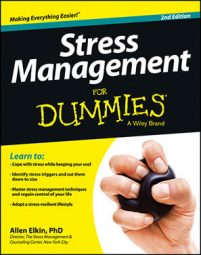Understanding why you worry will only get you so far — you need useful solutions to your worrying problems. This short list takes you to that next level, giving you the tools you need to change how you worry and help you start to worry less (and, at times, not at all).
Write about your worries
You’d be surprised that by spending just a few moments writing about your worries, you can weaken their power. Recent research findings reported in the Journal of the American Medical Association show that writing about stressful and worrisome experiences can reduce stress-related symptoms.
By writing down your worries, you begin to feel that you’re more in control of them. Much of your worrying goes on in a vague, ill-defined manner. Sometimes you aren’t even quite sure what you’re worrying about. By committing your worries to paper, you’re dealing with them in a more direct way. Instead of floating around out there somewhere, they’re now in a concrete form, recorded forever.
You don’t have to write volumes. In the study cited in JAMA, patients wrote for only 20 minutes a day for three consecutive days, and about half of them experienced positive effects that seemed to last for months.
Schedule your worries
When you have a major worry, you quickly discover that the worry can be forceful and insistent. One way of combating this is, oddly enough, to do your worrying at designated times. Build worrying into your day. Call this your worry time.
Whenever you sense that your worries are creeping into your mind, remind yourself that it’s not yet your worry time and that the worrying will have to wait. Jot down this worry in a worry diary, notebook, or day planner that you use for other appointments.
Assign yourself a time to worry. Start with 20 minutes. It could be during a coffee break, just after lunch, or on your trip home after work. If you find that 20 minutes is too much time, cut back by five minutes until you find your optimal worrying period.
The value of this approach is that it provides you with a sense of having addressed the worry. You’ll be able to worry about whatever is bothering you — but only at a specified time. This approach allows you to feel more comfortable not worrying (or at least worrying less) for the rest of your day.
To practice this scheduled and concentrated form of worry control, start with a smaller worry and work up to your most distressing concerns. From your worry list, choose a worry that is manageable and not overwhelming. Choose items from your list that are not triggering higher levels of worry. To start, stay away from the eights, nines, and tens and after a while move up to your more formidable worries.
Have a place to worry
You may need a worry corner — a place or places where you go to worry (either productively or unproductively). You then restrict your worrying to these special places as much as possible. These places become associated in your mind with worrying.
In the same way that having a worrying time gives you permission to defer your worrying until a specific time, having a worry place gives you permission not to worry in places that are associated with more positive aspects of your life.
It shouldn’t be your bed, because you don’t want to associate sleep or sex with worrying. It shouldn’t be at the dining-room table when you’re having dinner with the family. Try to make this place a tad uncomfortable, and not a place where you’d like to spend a great deal of time. It can be the bathroom at work or a stairwell.
It literally can be a corner. Find a corner in one of the rooms in your home that is infrequently used. Stick a stool there. Make that your place of worry. When you find yourself starting to worry in other places, gently remind yourself that this is neither the time nor the place to worry.

